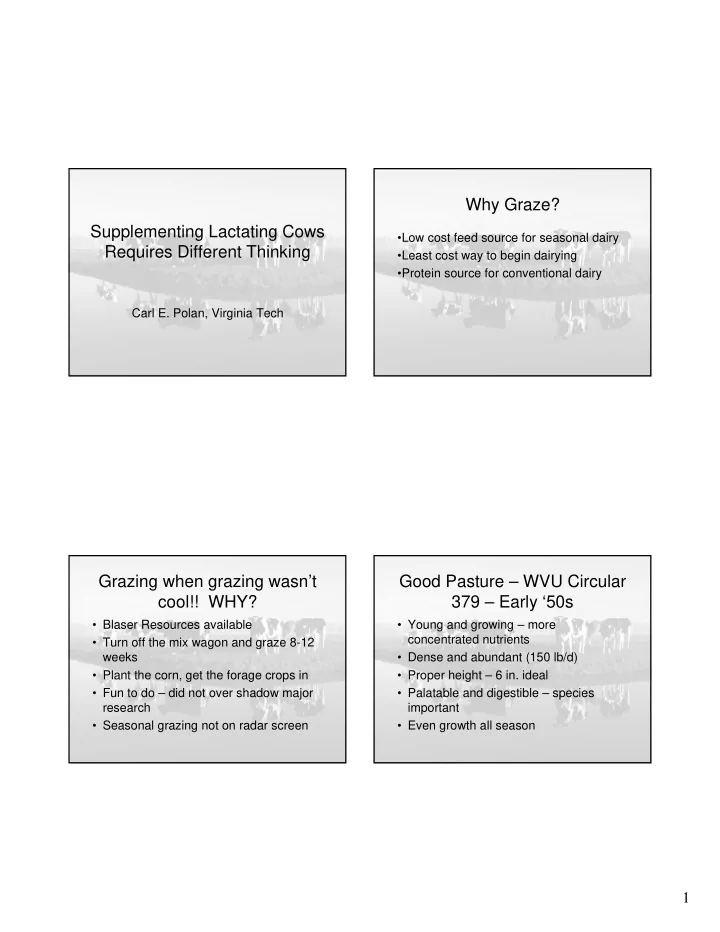

Why Graze? Supplementing Lactating Cows •Low cost feed source for seasonal dairy Requires Different Thinking •Least cost way to begin dairying •Protein source for conventional dairy Carl E. Polan, Virginia Tech Grazing when grazing wasn’t Good Pasture – WVU Circular cool!! WHY? 379 – Early ‘50s • Blaser Resources available • Young and growing – more concentrated nutrients • Turn off the mix wagon and graze 8-12 weeks • Dense and abundant (150 lb/d) • Plant the corn, get the forage crops in • Proper height – 6 in. ideal • Fun to do – did not over shadow major • Palatable and digestible – species research important • Seasonal grazing not on radar screen • Even growth all season 1
What factors affect Composition of grass pasture supplementation Nutrient Spring Summer Crude protein % 23.0 20.0 RUP, % of CP 22.0 28.0 • Composition of cool-season swards Sol P, % of CP 32.0 28.0 • Limits on intake of pasture ADF % 26.0 31.0 NDF % 42.0 52.0 • Pasture protein: asset or liability NE, Mcal lb -1 0.75 0.72 Non-fiber CHO (NFC) 18.0 14.0 Modified Muller and Fales (1998) Recommended NE L for heavily lactating cow is 0.78 • • NE L of corn silage is 0.72 Limits on Intake • High producing cows drop a lot in milk when moved from TMR to pasture (Kolver and Muller, 1998) • Voisin – eat (work) no more than 8 h/d Grazed ryegrass TMR • Intake depends on biting rate and sward density and height Milk Yield 65 97 – Intake decreases in lower density stands DM Intake 41.8 (3.4% BW) 51.5 (3.9% BW) as height decreases (Mayne, 1997) ~20 lb grain • On pasture only, milk yield limited to 50- 55 lb/d 2
Pasture protein: Pasture protein: asset or liability asset or liability PLUS MINUS • Crude protein intake good if captured in • Excess NH 3 in blood costs energy, 3 to rumen 6 lb milk (Kolver, 1997) • Fermentable carbohydrates drive • Excess NH 3 may adversely affect microbial growth and N capture reproduction (MUN above 15-l6 mg/d) • Corn increases microbial yield 1.4 fold in continuous culture fermenters How much grain? How much grain? • Milk yield (55.2 lb) was not different due • Responses in milk yield are small with to CP (12 vs 16%) or amount of increments above 10 lb grain (Fat test ↓ ). supplement (14 or 21 lb). (Jones- • In 1995, Holsteins produced more milk Endsley et al., 1997). (67.8 vs. 61.4) when fed 20 vs 12 lb of • When corn-based (12% CP) grain was corn, brewers grains and whole supplemented at 0, 11, and 22 lb, milk cottonseed (Table 2). Jersey response yield was 48, 59, and 67 lb. DMI was 1.4 lb milk. increases with supplementation. (Reis and Combs, 2000) 3
Synchrony How much grain? • Synchronizing N and fermentable • Penn State (Muller, 1998) developed a energy in rumen may be useful (Kolver, table of feeding guidelines for grass- 1997). based dairying. Table 3 in Proceedings. • Grain several x daily, grain after a • Penn State has not shown grain period of grazing, or grains with different amounts are effective for milk yield rates of fermentability have not shown response. However, increments in promise grain increases intake in high-yielding • Feeding a partial TMR before rather cows and improves body condition with than after grazing captured more possible improved conception. ruminal N, but no effect on milk yield or • Grain feeding follows the law of components diminishing returns. Supplementing with mixed Substitution diets (TMR) • For each unit of grain fed, pasture DMI decreases 0.5-0.8 lb (Muller and Fales, • Provides intake adjustments with 1998). variation in pasture • With more grain, total DMI will likely • Stable base diet with less animal increase (Reis and Combs, 2000). adjustment • Feeding more grain extends supply of • Extra job to mix. Silage may spoil. grass (has advantages). • Our data – no advantage over corn • With silage or TMR, substitution rate is supplementation 1:1. • Makes sense if it supplies 60% or more of DMI (no data). 4
Protein supplementation Protein supplementation • Protein in grain (14-16%) may enhance • In other studies with bypass sources, intake including fishmeal, we have gotten no response. • Positive response (2.5 lb) in milk yield by replacing corn with soybean meal • My opinion – take care to capture (18% CP) and additional milk yield (4 lb) rumen N with carbohydrates and not be by replacing SBM with dried brewers concerned about bypass sources. and corn gluten meal (Table 4, • Energy is still first-limiting. Proceedings) Conclusions Conclusions • Intake can be increased by grain • Amounts of grain would usually be from supplementation. 10 to 20 lb. 1:4 ratio usually makes sense (>40lb milk) • Microbial protein synthesis will be increased. • 12% CP (with minerals) adequate; should be readily fermentable. • Reproductive disturbances and costs from excess N may be reduced. • Expect fat test to drop as starch increases in diet 5
Recommend
More recommend